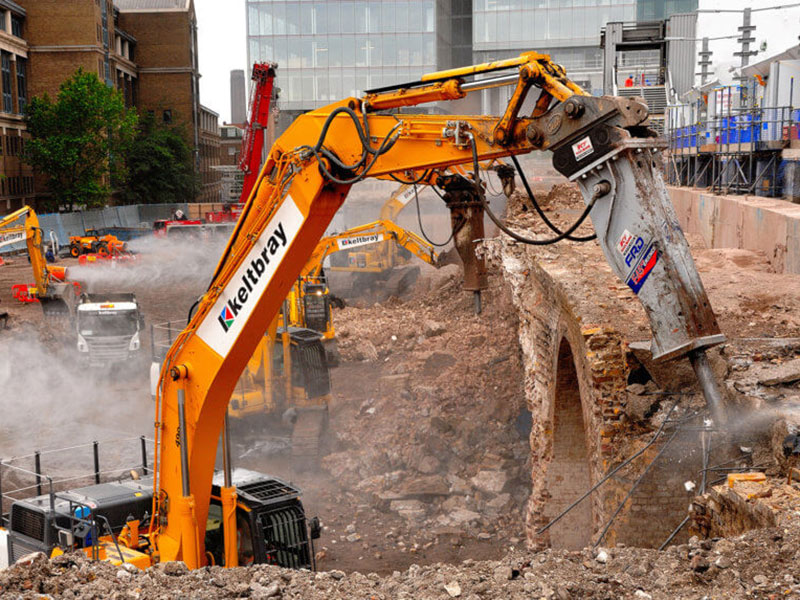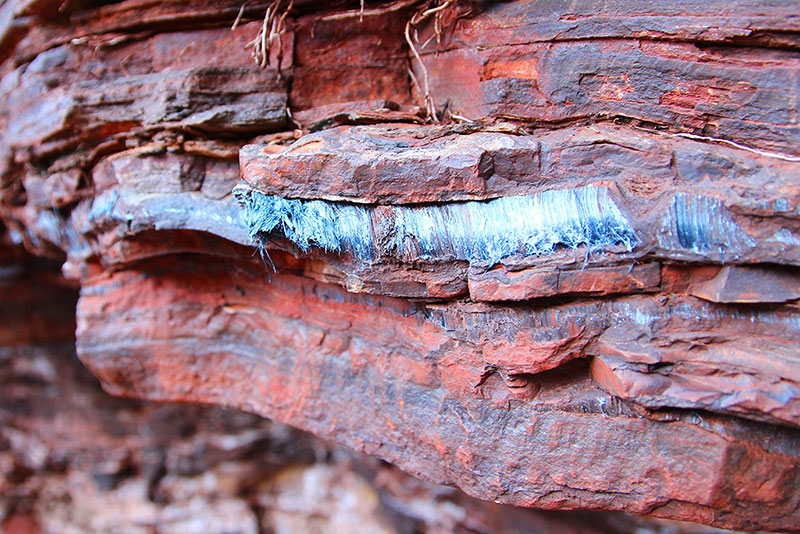What types of asbestos can be found in soil?
More than a generation has passed since asbestos was last legally used in the UK, the substance’s importation and use in such industries as construction and shipbuilding having been banned in this part of the world in 1999. However, the issue of asbestos and its potential risk to health is by no means one that has been relegated to the past.
A classic example of how this is the case, lies in the situation of asbestos found in soil. Asbestos in the ground might take the form of individual fibres that are barely discernible to the human eye, or even relatively intact asbestos-containing products, such as roofing sheets or pipe lagging.

The inhalation or ingestion of asbestos has come to be linked over the years with the potential development of extremely serious health conditions, such as mesothelioma and asbestos-related lung cancer. So, you can probably quickly understand the importance of taking proactive measures to identify, manage, and potentially remove such materials.
However, it is also crucial to appreciate that asbestos is not just one material. There are, in fact, six different types of asbestos, which can vary in their appearance, brittleness, and even the level of risk they pose to health (although there is no such thing as a type of asbestos that is “safe” for someone to come into direct contact with).
All these asbestos types, of course, can conceivably end up in soil. Knowing about the distinctions between the different types of asbestos, then, can greatly help you to identify them and make responsible decisions in the management of them.
Types of asbestos found in soil
There are various ways in which fibres of this naturally occurring fibrous silicate mineral have ended up in soil.
These include – but are not limited to – previous poorly managed asbestos removal works on the site, or even a building on the site having been demolished with asbestos-containing materials (ACMs) still inside. Asbestos can also end up in the ground due to relatively recent illegal waste disposal practices, or the “fly-tipping” of waste that contains asbestos.
Below, then, is a summary of the different types of asbestos materials that can be found in soil:
- Chrysotile: Also known as “white asbestos”, it is the most common form of asbestos, accounting for as much as 90% of asbestos used across the world. It is a white-coloured asbestos that is long, curly, and wavey in appearance, and is often found in soil near asbestos mines, factories, and buildings constructed before the 1980s.
- Amosite: Also known as “brown asbestos”, amosite is indeed light brown in colour, and was frequently used in construction materials. With its thin, needle-like fibres, and greater brittleness than white asbestos, it can be easy to inhale if disturbed. It can be found in soil close to industrial areas.
- Crocidolite: This is a blue asbestos that saw use for spray-on coatings, cement products, and insulation. It comprises extremely thin and brittle fibres, and is regarded as especially hazardous – even by asbestos standards – due to how prone it is to crumbling (“friability”) in the event of being disturbed. It can be found in soil near factories and industrial areas.
- Tremolite: This white-to-dark-green-coloured asbestos was only mined in small quantities, although it might be present in certain asbestos products such as asbestos cement sheets and asbestos insulation. It is often found in naturally occurring deposits, and can contaminate soil in areas where it is present.
- Actinolite: Darker in colour than other types of asbestos, actinolite nonetheless consists of long and sharp fibres that someone nearby can easily breath in. It can be found in soil near areas with ultramafic rock formations.
- Anthophyllite: Like tremolite and actinolite asbestos, this rare form of asbestos was not widely used on a commercial basis, although it did see use in certain products, such as composite flooring, vermiculite, and talcum powder. It has been known to be present in soil near ultramafic rock formations, as well as in areas with asbestos-contaminated vermiculite.
Common asbestos-containing materials that can be found in soil
Various asbestos-containing materials (ACMs) can be found in contaminated land; however, the specific types of ACMs present will depend on such factors as the land use history and any known or suspected sources of asbestos contamination.
Nonetheless, some of the most frequently discovered types of ACMs in asbestos-contaminated soil include:
- Building materials: Especially during its peak period of use in the UK from around the 1950s to the 1970s, asbestos saw common use in building materials such as roofing tiles, insulation, floor tiles, and cement pipes. These materials can become broken down, a process that in turn, releases asbestos fibres into the soil.
- Industrial waste: Waste arising from industrial processes – such as from mining operations, manufacturing facilities, and power plants – may also contain asbestos.
- Landfill waste: The disposal of asbestos-containing waste in landfills can lead to asbestos contaminating the surrounding soil.
- Natural deposits: It has often been presumed by many that asbestos must be a manmade substance; however, it is actually a naturally occurring mineral. This raises the prospect of deposits of asbestos-containing rocks or soils potentially contaminating the surrounding land.
Common locations for asbestos-contaminated soil
Asbestos-contaminated soil can be found in a variety of locations. These include:
- Former industrial sites: Asbestos saw extensive use in industrial processes and products. So, it should be unsurprising that asbestos-contaminated soil can sometimes be found close to old factories, refineries, power plants, and other industrial sites.
- Construction sites: Asbestos-containing materials were commonly used in the construction of domestic, commercial, and public buildings alike, up and down the UK. Soil that has been contaminated with asbestos may be found near sites where older buildings are being demolished or renovated.
- Landfills: As mentioned above, ACMs have been known to be disposed of in landfills. In cases where this has occurred, including on former landfill sites, soil nearby may be contaminated with asbestos.
- Natural deposits: Again, as we referenced above, asbestos is a naturally occurring mineral. So, it is important to be aware of the risk of asbestos contamination in the land that surrounds deposits of asbestos-containing rocks or soils.
- Residential areas: With ACMs being so frequently used in residential buildings – examples of such products including sprayed coatings, lagging, floor tiles, and asbestos cement products – there is also a chance of asbestos-contaminated soil being found near older homes or apartment complexes.
Testing for asbestos in soil
If you are responsible for land or soils that you suspect may be contaminated with asbestos, you will need to confirm whether this is, in fact, the case. And if asbestos does turn out to be present in the ground, you will also want to know what amount of asbestos is in the ground, as well as how deeply embedded it is, and the specific type of asbestos.
These are all things that you can find out with the help of a full asbestos contamination land survey. Here at Oracle Solutions, we can arrange for two types of site investigations to be carried out on land that is suspected to be contaminated with asbestos – asbestos-in-soils testing and Waste Acceptance Criteria (WAC) testing.
Managing asbestos-contaminated soil
The question of how to deal with asbestos-contaminated land is a highly specialised one. Nonetheless, it is of critical importance that you adopt every possible measure to keep people safe from possible asbestos exposure.
There are stringent regulations to be aware of in the UK, too, including the Control of Asbestos Regulations 2012, also known as CAR 2012. Although these regulations – which put in place a legal “duty to manage” asbestos – may not seem immediately applicable to asbestos in soil, the UK charity CL:AIRE (Contaminated Land: Applications in Real Environments) has put together an authoritative guidance document on this subject, with support from the UK Health and Safety Executive (HSE).
You may imagine that in the event of asbestos being found in soils for which you are responsible, you would have no choice but to remove the contaminated materials in order to ensure safety.
However, while this will be the decision that many dutyholders ultimately make, it is not necessarily the sole option. There may be some sites, for instance, where asbestos can be safely buried as deep fill. However, the subject of buried asbestos can be an emotive one, and it could also impact on the landowner’s ability to sell the site later.
If, then, you are unsure what your best options would be for removing asbestos-contaminated soils from your site, or at least managing it responsibly if it stays in the ground, you should always reach out to suitably qualified experts for help and advice.
Here at Oracle Solutions, we provide a comprehensive service for the management of asbestos contamination in soil, and can advise you on the best steps to take.
Are you adopting the most suitable measures for asbestos on your own premises?
Being well-informed on the six types of asbestos – chrysotile, amosite, crocidolite, tremolite, actinolite, and anthophyllite – including the differences and how to spot them, will greatly help you make the right decisions in relation to asbestos on your site. That is no less the case when asbestos might be buried in soil, and difficult to identify with the naked eye.
If you are concerned about possible asbestos in the soil of land for which you are responsible, please don’t wait any longer to contact the Oracle Solutions team for advice and guidance. We would be pleased to provide a highly competitive quote for any of our relevant asbestos services.

Written by Callum McDonald
Callum McDonald is an expert in asbestos quality management, ensuring rigorous adherence to regulations and high-quality standards in removal projects. His focus on enhancing quality and client satisfaction makes him a crucial asset in safety and compliance within the field. Callum's expertise in technical support and oversight of licensed works underscores his commitment to excellence in asbestos management, providing invaluable guidance to clients in this specialised area.

